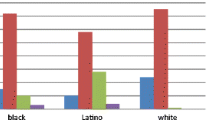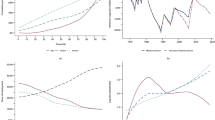Abstract
Most research on earnings inequality has focused on the growing gap between workers of different races and at different education, age, and income levels, but a large portion of the increasing inequality has actually occurred within these groups. This article focuses on the extent and sources of “within-group” wage inequality in more than 500 labor markets in the United States in 1990. In addition to documenting that within-group wage inequality across regions varies more widely today than over the past several decades, the analysis reveals that two frequently cited explanations of rising wage inequality over time have little impact on within-group wage inequality when measured at the local labor market level: (1) industrial shifts and (2) increased technology and trade. By contrast, flexible and insecure employment conditions (e.g., unemployment, contingent work, and immigration) are associated strongly with high local levels of within-group wage inequality, especially among women.
Similar content being viewed by others
References
Altonji, J. and D. Card. 1991. “The Effects of Immigration on the Labor Market Outcomes of Less-Skilled Natives.” Pp. 201–34 in Immigration, Trade, and the Labor Market, edited by J. Abowd and R. Freeman. Chicago: University of Chicago Press.
Bartik, T. 1991. Who Benefits From State and Local Economic Development Policies? Kalamazoo, MI: Upjohn Institute.
Bednarzik, R. 1993. “An Analysis of U.S. Industries Sensitive to Foreign Trade, 1982–1987.” Monthly Labor Review 2:15–31.
Belous, R. 1989. The Contingent Economy. Washington, DC: National Planning Association.
Bernard, A.B. and J.B. Jensen. 1998. “Understanding Increasing and Decreasing Wage Inequality.” Working Paper 6571, National Bureau of Economic Research, Cambridge, MA.
Bernhardt, A., M. Morris, and M. Handcock. 1995. “Women’s Gains or Men’s Losses? A Closer Look at the Shrinking Gender Gap in Earnings.” American Journal of Sociology 101:302–28.
Bernhardt, A., M. Morris, M. Handcock, and M. Scott. 1998. “Summary of Findings: Work and Opportunity in the Post-Industrial Labor Market.” Institute for Education and the Economy, Teachers College, Columbia University. Unpublished manuscript.
Blanchflower, D. and A. Oswald. 1994. The Wage Curve. Cambridge, MA: MIT Press.
Blau, F. and L. Kahn. 1995. “The Gender Earnings Gap: Some International Evidence.” Pp. 105–43 in Differences and Changes in Wage Structures, edited by R. Freeman and L. Katz. Chicago: University of Chicago Press.
—. 1996. “International Differences in Male Wage Inequality: Institutions Versus Market Forces.” Journal of Political Economy 104:791–837.
Borjas, G., R. Freeman, and L. Katz. 1996. “Searching for the Effect of Immigration on the Labor Market.” American Economic Review 86:246–51.
Bound, J. and H. Holzer. 1993. “Industrial Shifts, Skills Levels, and the Labor Market for White and Black Males.” Review of Economics and Statistics 75:387–96.
Bound, J. and G. Johnson. 1992. “Changes in the Structure of Wages in the 1980’s: An Evaluation of Alternative Explanations.” American Economic Review 82:371–92.
Bronfenbrenner, K. 1997. “Organizing in the NAFTA Environment: How Companies Use ‘Free Trade’ to Stop Unions.” New Labor Forum 1:51–60.
Bryk, A. and S. Raudenbush. 1992. Hierarchical Linear Models for Social and Behavioral Research: Applications and Data Analysis Methods. New York: Sage.
Card, D. and T. Lemieux. 1996. “Wage Dispersion, Returns to Skills, and Black-White Wage Differentials.” Journal of Econometrics 74:319–61.
DiNardo, J., N.M. Fortin, and T. Lemieux. 1996. “Labor Market Institutions and the Distribution of Wages, 1973–1992: A Semiparametric Approach.” Econometrica 64:1001–44.
Freeman, R. 1991. “Employment and Earnings of Disadvantaged Young Men in a Labor Shortage Economy.” Pp. 103–21 in The Urban Underclass, edited by C. Jencks and P. Peterson. Washington, DC: The Brookings Institution.
—. 1993. “How Much Has De-Unionization Contributed to the Rise in Male Earnings Inequality?” Pp. 133–63 in Uneven Tides: Rising Inequality in America, edited by S. Danziger and P. Gottschalk. New York: Russell Sage Foundation.
Frey, W. 1995. “The New Geography of Population Shifts.” Pp. 271–336 in State of the Union: America in the 1990s, vol. 2, edited by R. Farley. New York: Russell Sage Foundation.
Fujita, M., P. Krugman, and A. Venables. 1999. The Spatial Economy. Cambridge, MA: MIT Press.
Galbraith, J.K. 1998. Created Unequal: The Crisis in American Pay. New York: Twentieth Century Fund Book.
Gottschalk, P. 1997. “Inequality, Income Growth, and Mobility: The Basic Facts.” Journal of Economic Perspectives 11(2):21–40.
Gottschalk, P. and M. Joyce. 1995. “The Impact of Technological Change, Deindustrialization, and the Internationalization of Trade on Earnings Inequality: An International Perspective.” Pp. 197–228 in Poverty, Inequality, and the Future of Social Policy, edited by K. McFate, R. Lawson, and W.J. Wilson. New York: Russell Sage Foundation.
Gramlich, E. and C. Heflin. 1998. “The Spatial Dimension: Should Worker Assistance Be Given to Poor People or Poor Places?” Pp. 54–71 in Generating Jobs: How to Increase Demand for Less-Skilled Workers, edited by R. Freeman and P. Gottschalk. New York: Russell Sage Foundation.
Hallock, P., D. Hecker, and J. Gannon. 1991. “High Technology Employment: Another View.” Monthly Labor Review 114(7): 26–30.
Juhn, C., K. Murphy, and B. Pierce. 1991. “Accounting for the Slowdown in Black-White Wage Convergence.” Pp. 107–43 in Workers and Their Wages, edited by M. Kosters. Washington, DC: American Enterprise Institute.
Kalleberg, A., E. Rasell, K. Hudson, D. Webster, B. Reskin, N. Cassirer, and E. Appelbaum. 1997. Nonstandard Work, Substandard Jobs: Flexible Work Arrangements in the U.S. Washington, DC: Economic Policy Institute.
Katz, L. and A. Krueger. 1991. “Changes in the Structure of Wages in the Public and Private Sectors.” Research in Labor Economics 12:137–72.
Katz, L. and K. Murphy. 1992. “Changes in Relative Wages, 1963–1987: Supply and Demand Factors.” Quarterly Journal of Economics 107:35–78.
Krueger, A. 1993. “How Computers Have Changed the Wage Structure: Evidence From Microdata, 1984–1989.” Quarterly Journal of Economics 108:33–60.
Krugman, P. 1991. Geography and Trade. Cambridge, MA: MIT Press.
Levy, F. and R. Murnane. 1992. “U.S. Earnings Levels and Earnings Inequality: A Review of Recent Trends and Proposed Explanations.” Journal of Economic Literature 30:1333–81.
McCall, L. 1998. “Spatial Routes to Gender Wage (In)equality: Regional Restructuring and Wage Differentials by Gender and Education.” Economic Geography 74:379–404.
—. 2000. “Gender and the New Inequality: Explaining the College/Non-College Wage Gap.” American Sociological Review 65:234–55.
McFate, K. 1995. “Introduction: Western States in the New World Order.” Pp. 1–26 in Poverty, Inequality, and the Future of Social Policy, edited by K. McFate, R. Lawson, and W.J. Wilson. New York: Russell Sage Foundation.
Moulton, B. 1986. “Random Group Effects and the Precision of Regression Estimates.” Journal of Econometrics 32:385–97.
—. 1995. “Interarea Indexes of the Cost of Shelter Using Hedonic Quality Adjustment Techniques.” Journal of Econometrics 68:181–204.
Murphy, K. and F. Welch. 1993. “Industrial Change and the Rising Importance of Skill.” Pp. 101–32 in Uneven Tides: Rising Inequality in America, edited by S. Danziger and P. Gottschalk. New York: Russell Sage Foundation.
Piore, M. and C. Sabel. 1984. The Second Industrial Divide: Possibilities for Prosperity. New York: Basic Books.
Quigley, J.M. 1998. “Urban Diversity and Economic Growth.” Journal of Economic Perspectives 12(2):127–38.
Rauch, J.E. 1993. “Productivity Gains From Geographic Concentration of Human Capital: Evidence From the Cities.” Journal of Urban Economics 43:380–400.
Riche, R., D. Hecker, and J. Burgan. 1983. “High Technology Today and Tomorrow: A Small Slice of the Employment Pie.” Monthly Labor Review 16(11):50–59.
Rodrik, D. 1997. Has Globalization Gone Too Far? Washington, DC: Institute for International Economics.
Sassen, S. 1991. The Global City. Princeton, NJ: Princeton University Press.
Schoepfle, G. 1982. “Imports and Domestic Employment: Identifying Affected Industries.” Monthly Labor Review 105(8):13–26.
Smith, S. 1991. “Sources of Earnings Inequality in the Black and White Female Labor Forces.” Sociological Quarterly 32:117–38.
Standing, G. 1995. “Labor Insecurity Through Market Regulation: Legacy of the 1980s, Challenge for the 1990s.” Pp. 153–96 in Poverty, Inequality, and the Future of Social Policy, edited by K. McFate, R. Lawson, and W.J. Wilson. New York: Russell Sage Foundation.
Topel, R. 1994. “Regional Labor Markets and the Determinants of Wage Inequality.” American Economic Review 84(2):17–22.
Tyson, L.D. 1992. Who’s Bashing Whom? Trade Conflicts in High-Technology Industries. Washington, DC: Institute for International Economics.
U.S. Council of Economic Advisors. 1998. 1997 Economic Report of the President. Washington, DC: U.S. Government Printing Office.
U.S. Department of Commerce. 1994a. 1987 Economic Census CDROM vol. 1: Report Series 1E [MRDF]. Washington, DC: U.S. Bureau of the Census [producer and distributor].
—. 1994b. Regional Economic Information System CD-ROM, 1969–1992 [MRDF]. Washington, DC: Bureau of Economic Analysis [producer and distributor].
Williamson, J. 1996. “Globalization and Inequality Then and Now: The Late 19th and Late 20th Centuries Compared.” Working Paper 5491, National Bureau of Economic Research, Cambridge, MA.
Xie, Y. and E. Hannum. 1996. “Regional Variation in Earnings Inequality in Reform Era Urban China.” American Journal of Sociology 101:950–92.
Author information
Authors and Affiliations
Additional information
This research was supported in part by a grant from the Rutgers Research Council. I am very grateful to the deputy editor at Demography and to an anonymous reviewer for their extremely helpful comments on an earlier version of this article.
Rights and permissions
About this article
Cite this article
Mccall, L. Explaining levels of within-group wage inequality in U.S. labor markets. Demography 37, 415–430 (2000). https://doi.org/10.1353/dem.2000.0008
Issue Date:
DOI: https://doi.org/10.1353/dem.2000.0008




